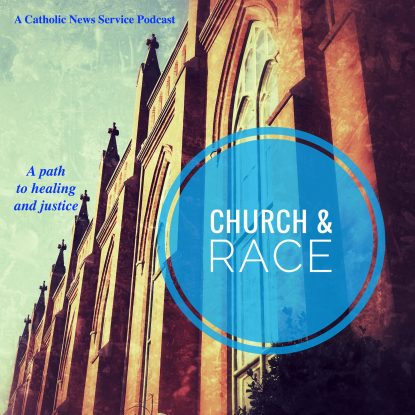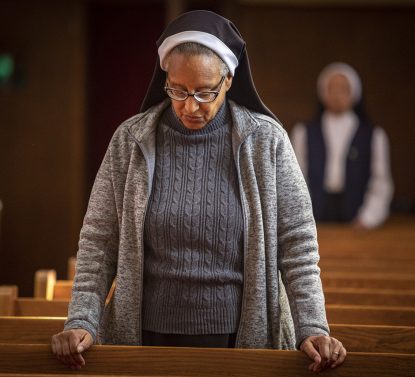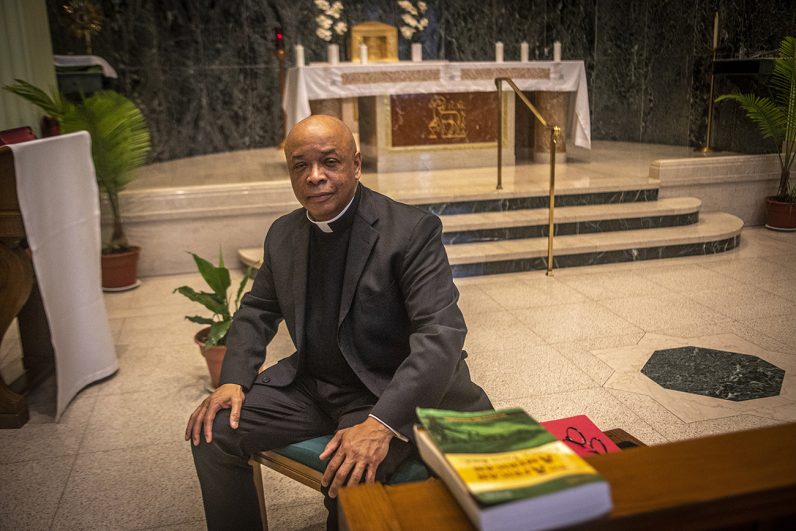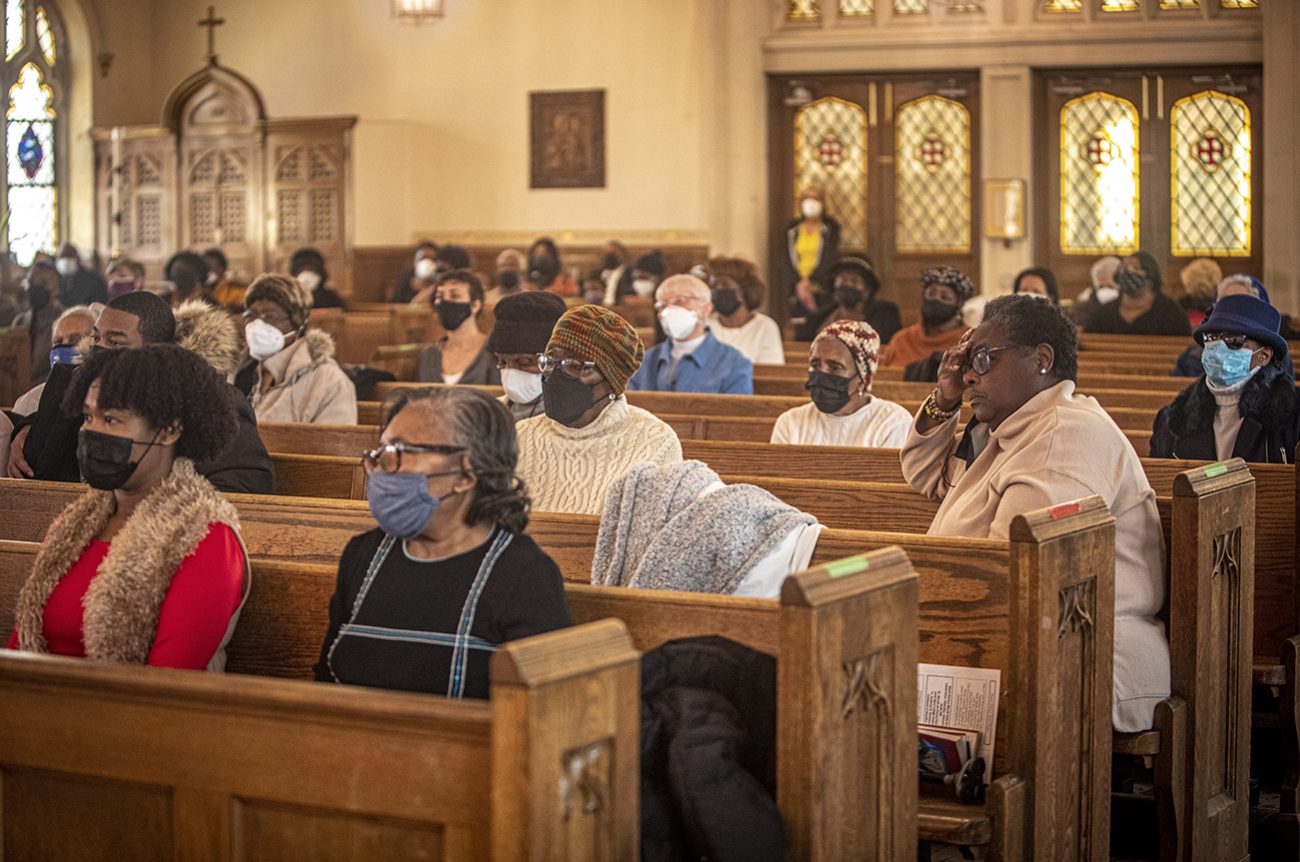PHILADELPHIA (CNS) — When Joseph Geeter retired from the U.S. Marine Corps and moved to suburban Philadelphia 20 years ago, he attended Mass at a few different Catholic churches with predominately white congregations near his new home in Montgomery County and was met with an unwelcoming reception.
“I wasn’t received there,” Geeter, a Black Catholic, told Catholic News Service during a February interview. “Folks wouldn’t even look at me and almost wouldn’t allow me in the pew. I could tell that I was definitely not wanted there.”
He had navigated racism in just about every American institution in his life and had learned how to peacefully exist in society despite it.
However, this wasn’t how he wanted to worship in the faith tradition he loved, so he contacted the Archdiocese of Philadelphia’s Office for Black Catholics, which offered a list of 10 city parishes with a predominately Black congregation, including St. Rose of Lima Parish in West Philadelphia.
Geeter found a welcoming parish at St. Rose and later St. Barbara in Philadelphia when the two parishes merged in 2013, without the burden of racism.
(Also in this second part of a series on “Church and Race” — see part one here — watch a video below and listen to a podcast here.)
It’s why many Black Catholics prefer to worship in churches with predominately Black congregations.
This, however, is not always possible in other locations around the United States.
It also may be a reason why there are so few Black Catholics in the U.S. and why they are the least likely of all Catholics to remain Catholic.
[hotblock]
“The share of Black Americans who were raised as Catholics and remain Catholics is lower than the corresponding shares of Hispanic and white Catholics,” according to a Pew Research Center study issued March 15. “Roughly half of Black adults who were raised Catholic still identify as Catholic (54%), compared with 61% of white adults and 68% of Hispanic adults.”
There are more than 72 million Catholics in the United States, according to a 2020 report by the Center for Applied Research in the Apostolate (CARA) at Georgetown University. Only about 3 million of them are Black.
Of the 35,513 priests in the U.S., 250 are Black, and of the 41,357 women religious in the U.S., 400 are Black.
When the late Auxiliary Bishop Joseph A. Francis of Newark, New Jersey — the fourth Black Catholic bishop named to serve the U.S. church and the principal author of the U.S. bishops’ 1979 pastoral on the sin of racism — was asked why there were so few Black Catholics in the U.S., he replied with the question, “Why are there so many?”
He pointed to Catholic Church’s history of being silent during the slave trade, Catholic institutions owning and selling slaves, continuing to have segregated schools, parishes and religious orders long after the post-Civil War laws ending slavery and well into the 20th century.

This is the logo for the 2022 Catholic News Service podcast series “Church and Race.” Episodes can be heard on Apple Podcasts, iHeart Radio and many other podcasting platforms. It can also be found on CatholicNews.com/podcasts (CNS illustration/Chaz Muth and Carol Zimmermann)
“Very few institutions in our country have done less to combat racism than the church,” Bishop Francis told a gathering of Catholics in Brooklyn, New York, in 1980.
As boldly as the bishop spoke about racism and the failings of the church on this issue, he remained Catholic, said Father Stephen Thorne, chairman of the Archdiocese of Philadelphia’s Commission for Racial Healing.
“One thing that is great about Black Catholics is that we know we are God’s children,” Father Thorne told CNS. “No matter what you may say, we know that, and we express that. We have a right to continue to be who God has called us to be. That is part of our struggle, that if we’re going to move forward and to evangelize, we must address these issues that sometimes impede evangelization.”
Many U.S. Catholic leaders acknowledge that racism continues to be a problem in the church.
The church — as an institution — began calling racism a sin decades ago.
Ridding the church of racism, however, has proven to be as difficult as it has been to rid the world of it, said retired Bishop Edward K. Braxton of Belleville, Illinois, one of the few American Black Catholic bishops.
[hotblock2]
The first step is to acknowledge a racist past, which the U.S. bishops did in the 1979 pastoral “Brothers and Sisters to Us” and again with the 2018 pastoral “Open Wide Our Hearts,” Bishop Braxton said, “where the church continues to express sorrow for — and commit to overcoming and ridding itself of … racial bias and prejudice toward different groups of people, including African Americans.”
All these writings, however, won’t make a difference if you can’t convince people to acknowledge that racism even exists, something many Americans have difficulty with, said Joseph A. Ferrara, vice president and chief of staff to Georgetown University’s president.
Georgetown and the Jesuits have made a very public reckoning with a history of owning and selling slaves, seen by some as a lesson for the rest of the Catholic Church and American society, but seen by others as pandering to radical liberals about a racial problem they say no longer exists.
Religion is a sacred part of a person’s life and that sacredness motivates many Black Catholics to worship in predominately Black populated spaces, said Oblate Sister Marcia Hall.
When Sister Marcia began to explore a vocation to religious life, she decided the Oblate Sisters of Providence — an historically Black congregation of women religious — was going to be the right fit for her.
“I felt that predominately white environments would be too toxic to live in,” she said. “I had worked in them; I had gone to school in them. I’d had enough racist experiences for two lifetimes, so I saw no reason to do that to myself for religious life.”

Oblate Sister Marcia Hall prays during Mass in the chapel of the mother house of the Oblate Sisters of Providence near Baltimore Feb. 9, 2022. (CNS photo/Chaz Muth)
Though Geeter said he will go to any church — regardless of the racial makeup of the congregation — to worship if he is out of town, his preference is to attend Mass with other Catholics “who look like me. Unless I’m in a church around people who look like me, I’m just not comfortable.”
According to the recent Pew study, only about 25% of Black Catholics worship in churches with a predominately Black congregation.
There are fewer than 800 U.S. Catholic churches with predominately African American congregations, most of which are on the East Coast, making it more likely that Black Catholics will attend Mass in predominately white congregations.
As Mass attendance nationwide has diminished in the past several decades, bishops have been forced to close or merge parishes. In many cases, the churches being closed have predominately Black congregations, Father Thorne said.
He would like to see these kinds of closure decisions made with more consideration of the consequences to Black congregations, “so it really can be a decision that is going to be in the best interest of everyone. Because when those parishes have closed, we have lost a lot of those people.”

Father Stephen Thorne, chairman of the Archdiocese of Philadelphia’s Commission for Racial Healing, is seen in the chapel at St. Joseph Seminary in Washington Feb. 22, 2022. (CNS photo/Chaz Muth)
PREVIOUS: ‘Dwell in the possibilities’ created by disability, says advocate
NEXT: To Ukraine with love: St. Hubert teens send words of hope overseas




Share this story